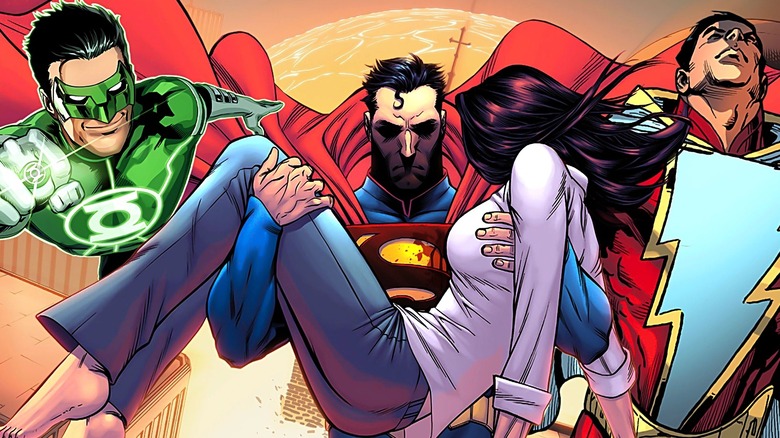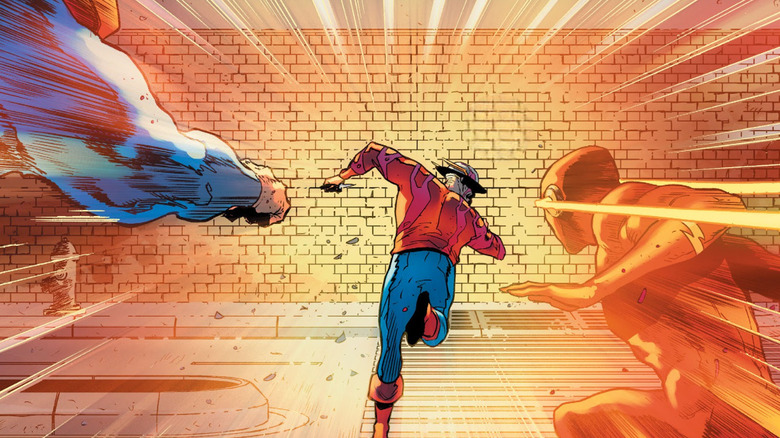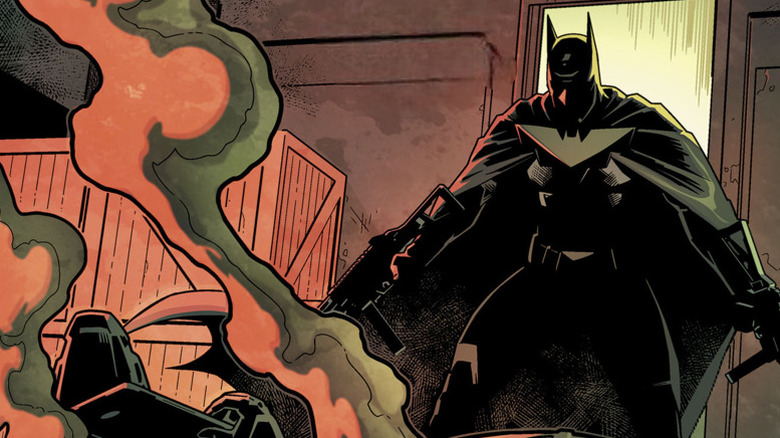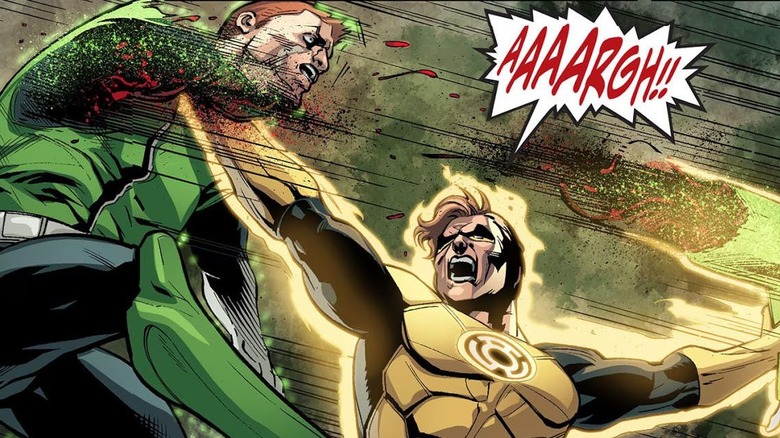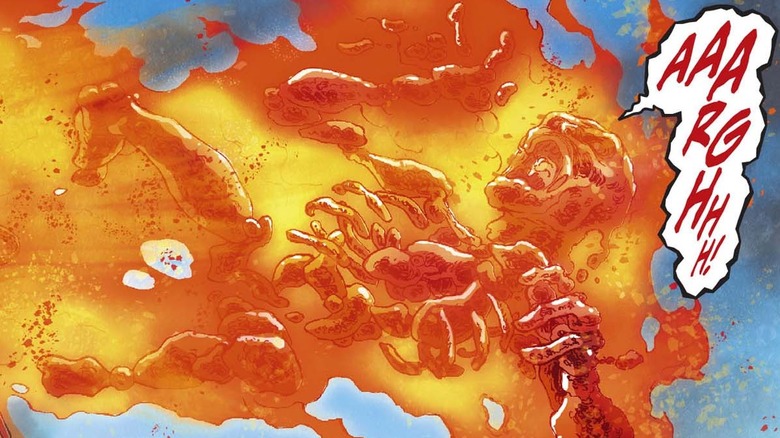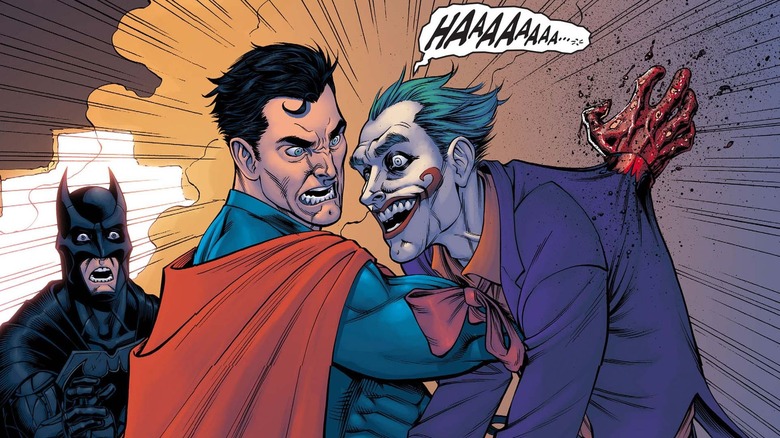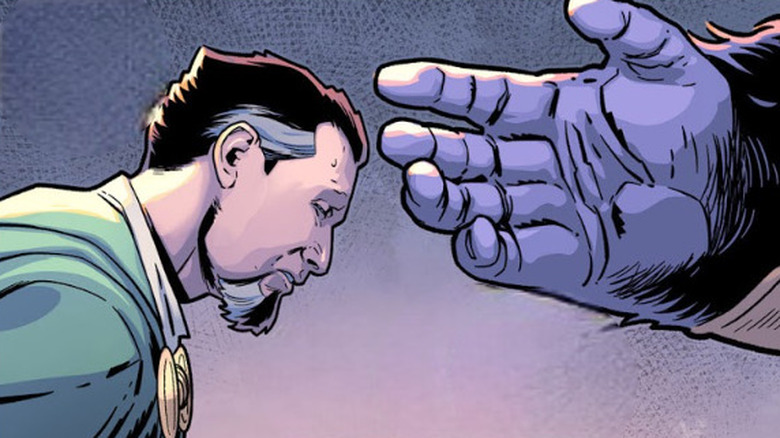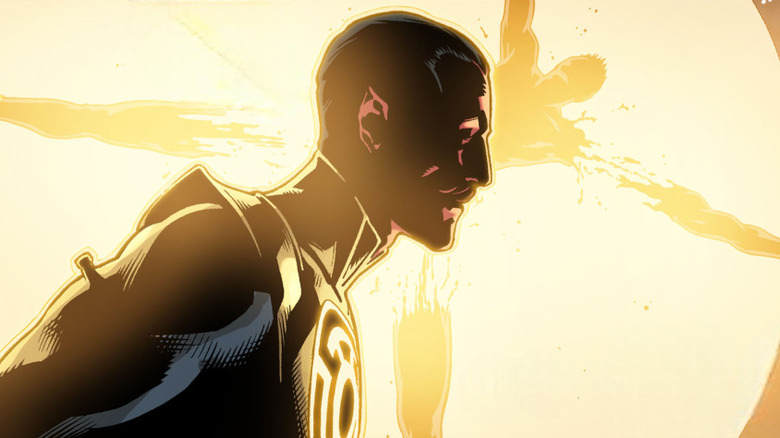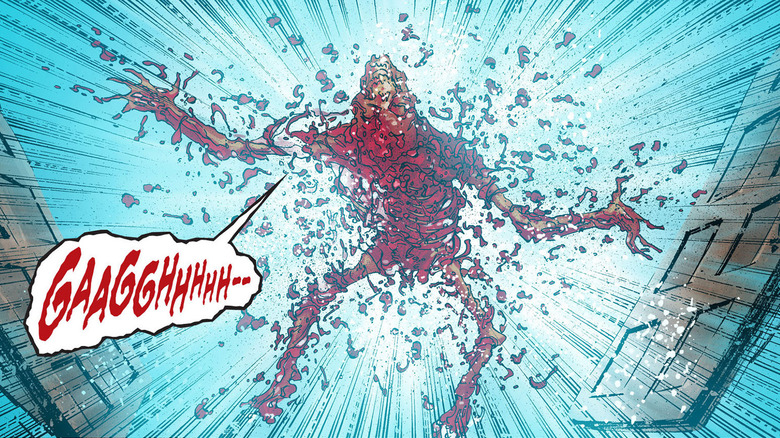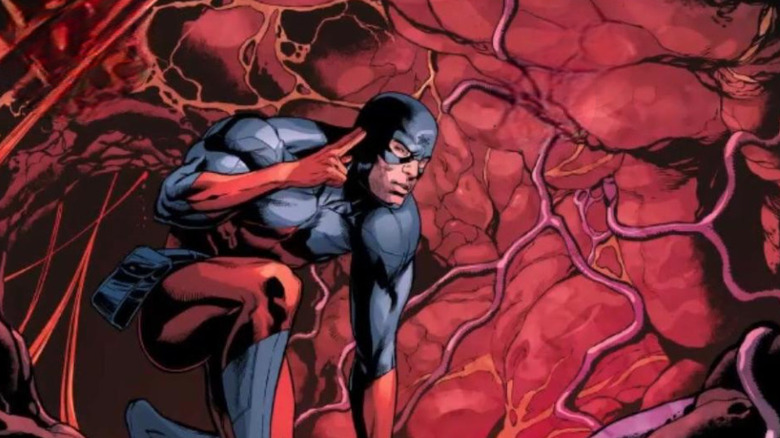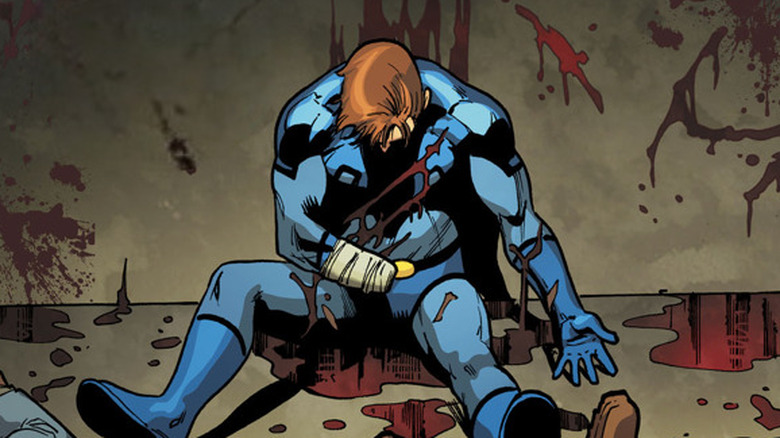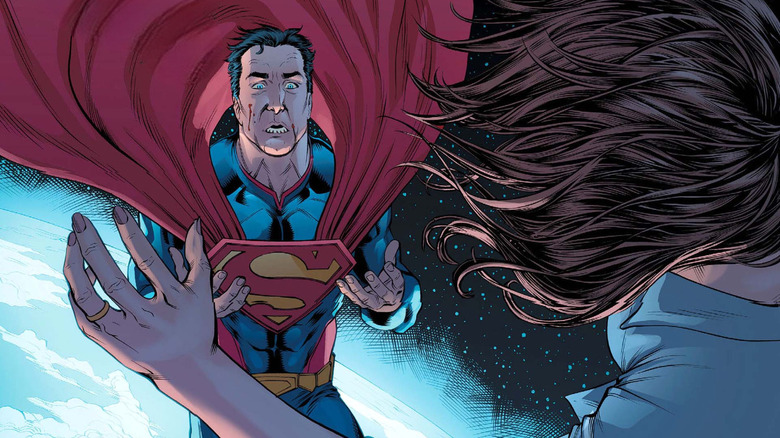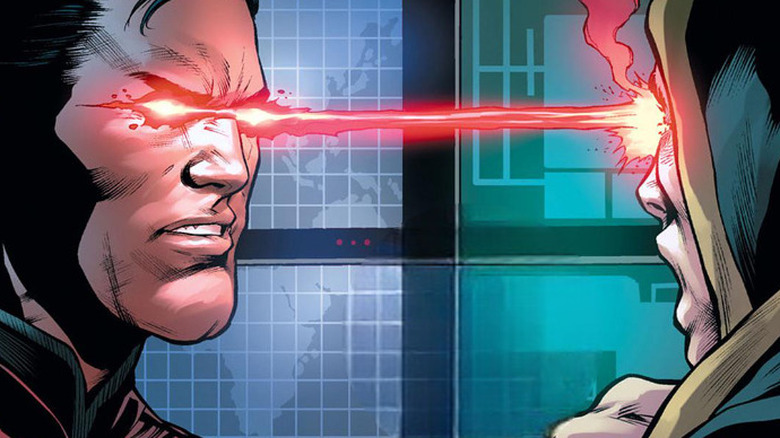12 Most Brutal Deaths In DC's Injustice Universe, Ranked
By far one of the best DC Comics video games ever made, "Injustice: Gods Among Us" and its sequel, "Injustice 2," have a well-earned place in the hearts of most fans. If it had simply been a worthy mash-up of recognizable superheroes and the time-tested gameplay of NetherRealm Studios' "Mortal Kombat" series, both games would have been as forgettable as 2008's "Mortal Kombat vs. DC Universe." However, "Injustice" boasts a surprisingly compelling storyline that elevates the games beyond simple 2D fighters, and has proven to captivate the imaginations of comic book fans after they put the controllers down.
Writer Tom Taylor and a litany of artists expanded upon this alternate world, which branches off from the mainstream DC Universe after the Joker orchestrates the death of Lois Lane and the nuclear destruction of Metropolis. This act pushed Superman over the edge, compelling him to take over Earth as its benevolent dictator, intent on permanently ending crime by any means necessary. The war between his One Earth Regime and the Insurgency of Batman's waning allies is a strikingly bloody epic that claimed the lives of many DC heroes and villains — often in brutal ways we never could have imagined.
12. Jay Garrick/The Flash
Anyone who played the first "Injustice" video game knows that, before any fighting can begin, players are initially greeted with this simple but memorable quote attributed to Lex Luthor: "I can say without a doubt that there are an infinite number of universes. Some are just like our own... but for one or two significant events, exactly the same." The quote wraps up the core concept of the "Injustice" universe. But for the death of Lois Lane and Metropolis, and all the horrors that unfolded as a consequence, it is exactly the same as the mainstream DC Comics universe. "Injustice: Year Zero" kinda trashes that whole idea.
This prequel series that takes place during the year before the Joker nuked Metropolis reveals that the Clown Prince of Crime had already begun irrevocably altering the status quo of his world long before he set his sights on Superman. Using an ancient artifact called the Amulet of Apophis, the Joker gains powers of total mind control, which he uses to corrupt the Justice Society of America. He starts by possessing the original Green Lantern, Alan Scott, using him to kill Sandman (Wesley Dodds) before accidentally letting Scott fall from a great height, putting him in a coma.
Once he gets the hang of his new powers, he uses the amulet to possess Jay Garrick, forcing the original Flash to use his super speed to cut the throats of countless innocent civilians. By the time Superman and Barry Allen arrive to assess the situation, the Joker has had his fun — and thus, disposes of his superpowered toy by forcing him to run at full speed into a brick wall. When the dust clears, all that Barry can recover is Jay's saucer.
11. Task Force X
In the "Injustice 2" comic book series, Tom Taylor further separates his world from that of the mainstream universe with a liberal amount of good ol' fashioned retconning. The alterations to the history of Jason Todd are particularly dramatic.
When Red Hood (Jason's vigilante alter-ego) was added to the second game as a DLC character with little background information, most readers assumed he was still a former Robin who was brought back from the dead to fight crime once more. However, Taylor's comic reveals that, after being killed by the Joker, Jason was resurrected by Ra's al Ghul and the League of Assassins, and was thereafter a member of their ranks from his rebirth through the events of the first "Injustice." It isn't until after the Regime falls that Ra's sends Jason back out into the world — not as Red Hood, but as a gun-toting Batman helping his new mentor build an army.
Jason's first stop is a meeting of a potential new Suicide Squad, reformed by Amanda Waller and Rick Flag, with villains like Harley Quinn being forced to rejoin in the aftermath of Superman's downfall. Before they can get started, Jason barges in as the Dark Knight and fires several rounds into the faces of both Waller and Flag. And though the Squad thinks they're being saved from indentured service, Jason informs them that some will be coming with him to serve the League. As for the rest, Jason wastes no time detonating the bombs in their necks, starting his Suicide Squad with a pile of bodies so large it would make James Gunn blush. Among the dead are Clock King, Killer Moth, and Polka-Dot Man.
10. Guy Gardner/Green Lantern
Guy Gardner's profile as a Green Lantern and a member of the Justice League has been getting some long-overdue help from Nathan Fillion's portrayal of the character in James Gunn's "Superman." Unfortunately, this only makes his fate in "Injustice" all the more heartbreaking.
Having been away from Sector 2814 at the time of Superman's rise to global domination, Guy is assembled alongside every other Green Lantern to bring the Kryptonian war criminal to justice during "Year 2." Inconveniently for the all-powerful Guardians of the Universe, Superman's forces have been augmented by the entirety of the fear-fueled Sinestro Corps. When they use their authority to strip a Regime-aligned Hal Jordan of his Green Lantern ring, it takes but a moment for Sinestro himself to grant the fallen hero a ring of fear.
Both this parasitic ring and the adversary-turned-ally that bestowed it upon him quickly corrupt Hal's weakened mind, encouraging him to embrace fear. To push him over the edge, Sinestro kills the Green Lantern John Stewart and blames his death on Guy. Despite Guy's attempts to be the voice of reason, the supercharged Hal pummels him and takes his Green Lantern ring — along with the limb it was attached to. Depowered, Guy falls bleeding from the heavens to his death as Hal callously watches.
9. J'onn J'onzz/Martian Manhunter
While many readers may be split on the drastic changes introduced by the "Injustice" comic series to the continuity of the games, at least in the case of J'onn J'onzz, Tom Taylor was able to make much better use of him. Like Jason Todd, Martian Manhunter was merely a DLC character in the original "Injustice" video game, added with no narrative context save for a short, narrated epilogue of his brief arcade campaign. It's revealed through this that J'onn declined to choose a side of the conflict, instead going into hiding by shape-shifting into a member of the Atlantean royal council. During the climax of the game, which saw the Superman from the mainstream DC Universe join his allies to take on the "Injustice" Superman, J'onn is said to have emerged from exile to help save civilians caught in the fray.
In the comics, however, Martian Manhunter joins Batman's insurgency during its first year, serving as the Dark Knight's closest ally and spy. After Superman unmasks Bruce Wayne's secret identity to the world, he assumes the role of Bat-decoy, leading Superman and Wonder Woman on a chase to give the real Batman time to regroup. J'onn reveals himself during the battle by using his powers and makes a plea to Superman, appealing to their shared tragedy as outsiders from planets destroyed by corrupt leaders. Wonder Woman attacks the Martian, forcing him to retaliate by using his shape-shifting powers to invade her nostrils and mouth. She begs Superman to use his heat vision to flush J'onn out. It works a little too well, as he evacuates her body as a lifeless mush of bones, flesh, and organs.
8. The Joker
The changes made by "Injustice: Year Zero" aside, the comic at least gave us more time with this world's version of the Joker. Though the Agent of Chaos features prominently in the video game, the "Injustice" comics will not satisfy any readers looking for a great Joker story to enjoy.
This is, of course, because the Joker has arguably the most memorable, impactful, and consistent death of anyone in the series early on, depicted identically in both the comics and the video games. Having successfully carried out his act of terror against Superman and the world he loves so much, Joker is swiftly taken into custody by Batman. Before he can even process what should be done with his archnemesis after such an unthinkable crime, Superman breaks into the interrogation room and — in spite or perhaps because of the Joker's taunts about the Big Blue Boy Scout's unshakable moral code — he kills the clown in a fit of rage by plunging his fist through the Joker's chest.
In an alternate, alternate, dream reality branching off from the main "Injustice" comics, Batman actually recognizes that the Joker has done so much damage that Superman could be driven to murder. To protect his friend, Batman takes it upon himself to break the Joker's neck while in his custody. He then immediately turns himself in and reveals his true identity as Bruce Wayne to the public, even declining Superman's offer to break him out of prison.
7. Ra's Al Ghul
Despite not really appearing in either "Injustice" video game even as a background character for players to bash into during stage transitions, Ra's Al Ghul plays a pretty major role in the "Injustice 2" comic book series. It makes sense from a narrative perspective, given that the leader of the League of Shadows is one of Batman's most important villains in the comics, that he would have some impact on a story that disrupts the entire DC Universe — even if that impact ends with an especially brutal "scruntch."
Ra's is initially successful in rallying the Suicide Squad and many other DC Comics villains (almost entirely those featured on the playable roster of "Injustice 2") but his time as their leader is short lived. In his hubris, he is eventually betrayed by Gorilla Grodd, who weaponizes the villains' resentment of Ra's control against the Demon's Head. Using his powers of mental manipulation, Grodd forces Ra's to kneel before him and calmly crushes his skull with a single fist. It's a truly disconcerting death for a man who thought he would never die.
6. Kyle Rayner/Green Lantern
Compared to most of the other characters on this list, Kyle Rayner doesn't have a large role at all in the "Injustice" universe. And yet, in a way that's depressingly impressive, Tom Taylor still manages to make his death feel devastating.
Like Guy Gardner, Kyle was away from his Green Lantern sector when Metropolis was destroyed, and thus returns during "Year 2" oblivious to everything that had changed. On his way to Earth, he is intercepted by Sinestro and a small squad of Yellow Lanterns, who string him up by his limbs. Maintaining his characteristic sense of cool, Kyle quips and tries to send a beacon to Oa. Before he can, however, Sinestro pulls his ring finger off his hand, robbing him of his will-powered environmental protection from the cold vacuum of space.
To make sure Kyle suffers as much pain as possible in his last moments, Sinestro and his lackeys actually put a protective bubble around him — only so they can slowly tear him limb from limb.
5. Jason Blood/The Demon Etrigan
Part of what makes Tom Taylor's "Injustice" series so fun is his ability to take a fairly mainstream storyline featured in a massively popular video game and find natural ways to incorporate some weirder DC Comics favorites who would normally be sidelined by the pursuit of mass appeal. Even the demon Etrigan gets a prominent storyline in "Injustice: Year 3," albeit one that ends in unimaginable agony.
For those unaware, Etrigan is a demon (and devilishly good poet) who walks among mortals with the aid of a human host, most commonly Jason Blood. He fights on the side of the angels, often serving as a member of the occult-oriented Justice League Dark (he likely would've appeared in Guillermo del Toro's adaptation, if the entire project hadn't been abandoned in development hell). In "Year 3," however, he is seemingly betrayed by one of his mystical brethren when the nigh-omnipotent Spectre (secretly an extradimensional imp named Mr. Mxyzptlk in disguise) uses his supernatural gifts to flay Etrigan alive. Though Etrigan merely returns to Hell in search of another host, Jason Blood is gone for good.
4. Ray Palmer/The Atom
Some "Injustice" fans were a little surprised when "Injustice 2" chose legacy character Ryan Choi as the Atom of the sequel video game. And since he only appeared as a playable DLC character, no one was given a real reason why Ray Palmer (the original Atom, whom readers may remember from the heyday of the Arrowverse) had been omitted from this universe, or whether or not he had survived Superman's Regime.
Tom Taylor revealed in the "Injustice: Year 5 — Annual" #1 issue that Palmer was indeed aligned with Superman and the One Earth Government prior to Batman's victory. It's worth noting, however, that we never see him participating in the rounding up of heroes or on the front lines of Superman's war — primarily, if not entirely, his mission was leading the official reconstruction of Metropolis. After the Regime fell, Palmer seemingly regretted his allegiance to Superman and even went on to serve as his prison guard.
He eventually became a full member of Batman's team of superheroes, fighting alongside them during Amazo's assault on India. When he attempts to shut down the android by shrinking his way into his robot nose, however, Amazo's defenses deploy bug-like nanobots that eat Ray Palmer alive.
3. Ted Kord/Blue Beetle
Like Ray Palmer, Ted Kord is another Justice Leaguer who was leapfrogged by a legacy character for "Injustice 2." Given how much more popular Jaime Reyes is as the Blue Beetle (not to mention better suited for a fighting game), there was less to wonder about as to why the decision was made in this case. That didn't stop Tom Taylor from writing a tragic send-off for Ted in the "Injustice 2" comic book series.
After a night of training with Jaime and a visit from Bruce Wayne (inviting the millionaire CEO of Kord Industries to join a collective trying to make real, restorative change in the aftermath of the One Earth Government), Ted is visited by his time-travelling best friend Booster Gold. Somberly, Booster lets Ted know that, despite multiple attempts on his part to change the future (a process that took several years of his own life), Ted's death is at hand. He promises to be with him when the time comes. However, until that time, both men agree the Blue Beetle should go down swinging.
Sure enough, Ted is abducted by Ra's al Ghul's forces moments later, putting up a decent fight before losing his hand to Katana (luckily it wasn't his foot — her sword does trap the soles of its victims, after all). He is then brought before Ra's himself, who was unaware of Ted's secret identity and merely wanted to make an example of some of the world's most powerful people. Alongside other industrialists, Ted is mauled to death by Killer Croc and Orca. True to his word, Booster arrives as Ted succumbs to his wounds, comforting him at the end.
2. Lois Lane
The killing of Lois Lane in "Injustice" easily stands out as one of the worst things the Joker has ever done in any universe, both in terms of its impact on the world and the sheer inhumanity of his motives and methods. What often goes overlooked is that the Joker came after Superman completely unprovoked. There was no bounty, no slight, real or imagined, no pathological obsession as is the case with his torment of Batman. No — he simply got bored.
The "Injustice" video game hints at what the Joker did in its opening cutscene, but it wasn't until Tom Taylor's series that fans understood the full extent of his chilling scheme. Essentially, the Joker uses a Kryptonite-laced variant of the Scarecrow's fear toxin to trick Superman into thinking he is fighting his monstrous nemesis Doomsday. In reality, Superman is "fighting" Lois Lane, whom the Joker had kidnapped earlier. That Superman essentially beats his own pregnant wife to death — so hard that the battle ends above Earth's atmosphere — is horrific enough. But of course, the Joker being the Joker, her still heartbeat was also used as the trigger for the nuclear weapon that destroyed Metropolis.
1. Billy Batson/Shazam
Of all the deaths from the "Injustice" universe, none have stuck with us quite like the murder of Billy Batson. A young boy who can turn into a god-like superhero by invoking the name of the wizard Shazam, it was always somewhat confusing that he had chosen to side with the Regime despite possessing the mighty wisdom of Solomon. Then again, what child wouldn't look up to a hero as legendary as Superman?
Tragically and poetically, looking up to Superman is exactly how Billy ultimately dies in the first "Injustice" video game. With the alternate Justice Leaguers closing in, and Superman prepared to escalate his pursuit of total control by decimating Gotham City, Shazam bravely stands up against his hero and urges him to see how inhuman his plans are. In response to this challenge, Superman grabs him by the throat. Panicking, Billy tries to shout the wizard's name and likely call down a lightning bolt, but Superman freezes his mouth shut before he can.
As Shazam looks at Superman with terrified eyes, Superman uses his heat vision to slowly burn a hole through his skull, refusing to stop until the muffled screams are silenced. This death is undoubtedly the most memorable of any "Injustice" death, and is arguably the moment that robbed players of any faith in Superman's redemption.
